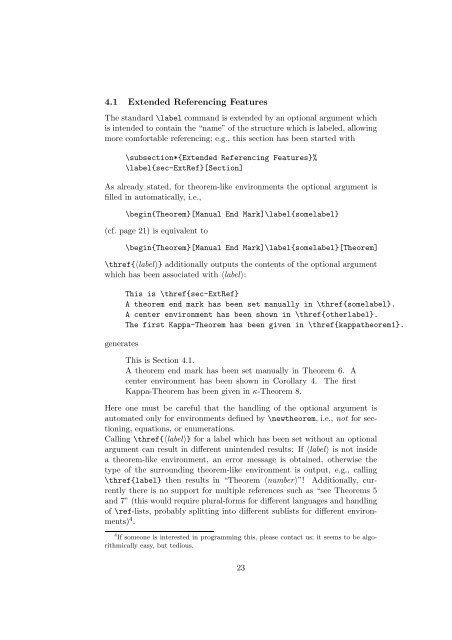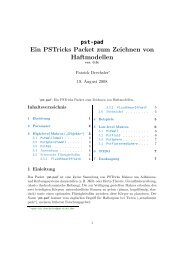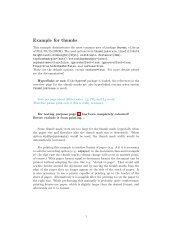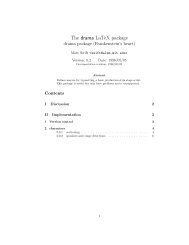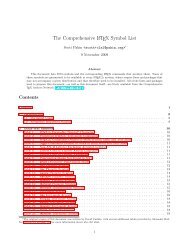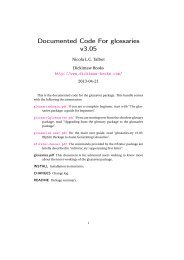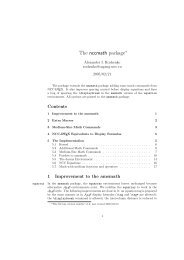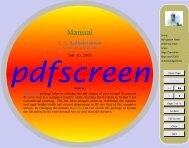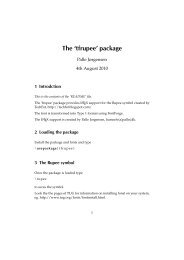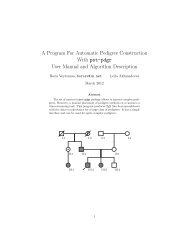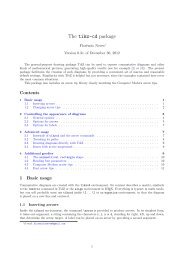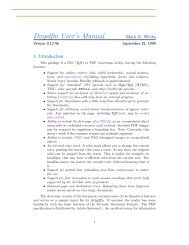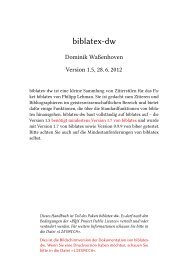ntheorem.pdf. - Mirrors.med.harvard.edu
ntheorem.pdf. - Mirrors.med.harvard.edu
ntheorem.pdf. - Mirrors.med.harvard.edu
You also want an ePaper? Increase the reach of your titles
YUMPU automatically turns print PDFs into web optimized ePapers that Google loves.
4.1 Extended Referencing Features<br />
The standard \label command is extended by an optional argument which<br />
is intended to contain the “name” of the structure which is labeled, allowing<br />
more comfortable referencing; e.g., this section has been started with<br />
\subsection*{Extended Referencing Features}%<br />
\label{sec-ExtRef}[Section]<br />
As already stated, for theorem-like environments the optional argument is<br />
filled in automatically, i.e.,<br />
\begin{Theorem}[Manual End Mark]\label{somelabel}<br />
(cf. page 21) is equivalent to<br />
\begin{Theorem}[Manual End Mark]\label{somelabel}[Theorem]<br />
\thref{〈label〉} additionally outputs the contents of the optional argument<br />
which has been associated with 〈label〉:<br />
generates<br />
This is \thref{sec-ExtRef}<br />
A theorem end mark has been set manually in \thref{somelabel}.<br />
A center environment has been shown in \thref{otherlabel}.<br />
The first Kappa-Theorem has been given in \thref{kappatheorem1}.<br />
This is Section 4.1.<br />
A theorem end mark has been set manually in Theorem 6. A<br />
center environment has been shown in Corollary 4. The first<br />
Kappa-Theorem has been given in κ-Theorem 8.<br />
Here one must be careful that the handling of the optional argument is<br />
automated only for environments defined by \newtheorem, i.e., not for sectioning,<br />
equations, or enumerations.<br />
Calling \thref{〈label〉} for a label which has been set without an optional<br />
argument can result in different unintended results: If 〈label〉 is not inside<br />
a theorem-like environment, an error message is obtained, otherwise the<br />
type of the surrounding theorem-like environment is output, e.g., calling<br />
\thref{label} then results in “Theorem 〈number〉”! Additionally, currently<br />
there is no support for multiple references such as “see Theorems 5<br />
and 7” (this would require plural-forms for different languages and handling<br />
of \ref-lists, probably splitting into different sublists for different environments)<br />
4 .<br />
4 If someone is interested in programming this, please contact us; it seems to be algo-<br />
rithmically easy, but tedious.<br />
23


